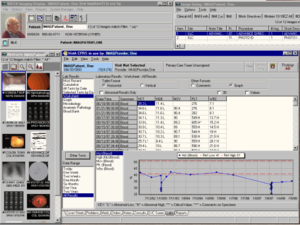
Vista imaging
Encyclopedia

Hardware requirements
The VistA Imaging System uses hardware components to provide short- and long-term storage. It takes advantage of network servers for storage. It uses a DICOMDigital Imaging and Communications in Medicine
DICOM is a standard for handling, storing, printing, and transmitting information in medical imaging. It includes a file format definition and a network communications protocol. The communication protocol is an application protocol that uses TCP/IP to communicate between systems...
gateway system to communicate with commercial Picture Archiving and Communication Systems
Picture archiving and communication system
A picture archiving and communication system is a medical imaging technology which provides economical storage of, and convenient access to, images from multiple modalities . Electronic images and reports are transmitted digitally via PACS; this eliminates the need to manually file, retrieve, or...
(PACS) and modalities such as CT, MR, and Computed Radiography (x-ray) devices for image capture. It utilizes a background processor for moving the images to the proper storage device and for managing storage space.
Types of data managed
The system not only manages radiologic images, but also is able to capture and manage EKGsElectrocardiogram
Electrocardiography is a transthoracic interpretation of the electrical activity of the heart over a period of time, as detected by electrodes attached to the outer surface of the skin and recorded by a device external to the body...
, pathology
Pathology
Pathology is the precise study and diagnosis of disease. The word pathology is from Ancient Greek , pathos, "feeling, suffering"; and , -logia, "the study of". Pathologization, to pathologize, refers to the process of defining a condition or behavior as pathological, e.g. pathological gambling....
images, gastroenterology (endoscopic)
Endoscopy
Endoscopy means looking inside and typically refers to looking inside the body for medical reasons using an endoscope , an instrument used to examine the interior of a hollow organ or cavity of the body. Unlike most other medical imaging devices, endoscopes are inserted directly into the organ...
images, laparoscopic
Laparoscopic surgery
Laparoscopic surgery, also called minimally invasive surgery , bandaid surgery, or keyhole surgery, is a modern surgical technique in which operations in the abdomen are performed through small incisions as opposed to the larger incisions needed in laparotomy.Keyhole surgery makes use of images...
images, scanned paperwork, or essentially any type of health care image.
Integration with Electronic Health Record systems
VistA Imaging is currently integrated into the VistA EMR (electronic medical record) system used nationwide in Department of Veterans Affairs hospitals. This integration is able to provide increased efficiency of retrieval of images. It has also been used as a separate software package and can be used with EHRsElectronic Health Record
An electronic health record is an evolving concept defined as a systematic collection of electronic health information about individual patients or populations...
other than VistA.
VistA Imaging now connects to a nationwide backbone that allows clinicians to access the 350 million images stored in the VA system via Remote Image View software.
The VA has developed interfaces for more than 250 medical devices in VistA Imaging, the images from which can be accessed through the desktop VistA Imaging Viewer. The Department of Defense will use the VistA Imaging Viewer to enhance its own EHR.
Usage in a National Network of Healthcare Records
As part of the US national mandate to co-ordinate care between Department of Defense and the VA, VistA Imaging is forming a cornerstone of the effort to exchange medical imagery between the two systems. “When soldiers come back from Iraq and Afghanistan and eventually enter the VA system, images will be able to move from DOD to VA seamlessly." Eventually, DOD and VA should be able to share all image file types from all sites. Additional enhancements to VistA Imaging include development of a central archive for all VA images (whether acquired through VistA or a commercial system) and new indexing and search capabilities.Availability
The software for VistA Imaging has been made available through the Freedom of Information ActFreedom of Information Act (United States)
The Freedom of Information Act is a federal freedom of information law that allows for the full or partial disclosure of previously unreleased information and documents controlled by the United States government. The Act defines agency records subject to disclosure, outlines mandatory disclosure...
so that it is in the public domain. Due to its designation as a medical device, however, it can not be designated as free open source software and therefore can not be altered or implemented without FDA approval. This was done intentionally to limit the distribution of VistA Imaging.
Although it can be used in healthcare facilities that are outside the Department of Veterans Affairs
United States Department of Veterans Affairs
The United States Department of Veterans Affairs is a government-run military veteran benefit system with Cabinet-level status. It is the United States government’s second largest department, after the United States Department of Defense...
, this is possible only if the proprietary modules that have been integrated into it are also licensed and implementation is registered with the FDA. This has effectively limited its use to government institutions who have licensed the proprietary modules.
It is nominally available through the Department of Veterans Affairs software request office for a fee of around $15.

